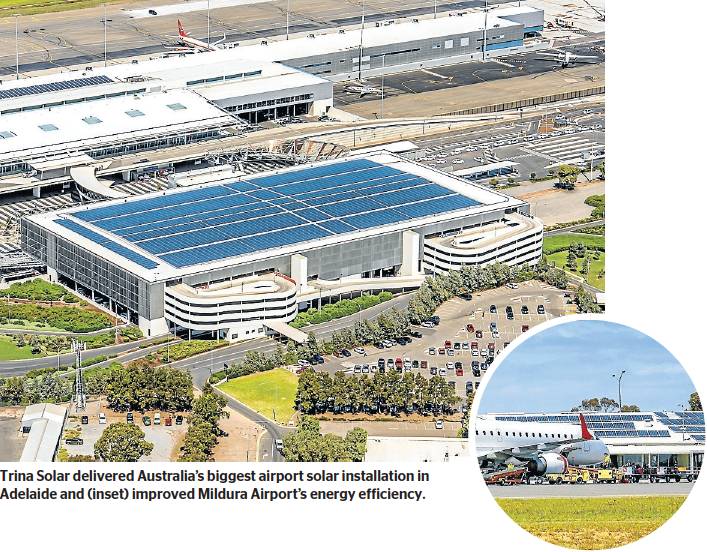Bright future for commercial solar solutions
Competition is driving continual innovation in the delivery of solar power.
Every day, as passengers pass through Mildura Airport on the Victoria-NSW border, they are in the presence of what solar power can achieve on a commercial industrial scale.
Passengers might not notice the 400 modules soaking up the sun’s rays on the roof, yet their journey from origin to destination is a triumph of solar energy; it powers the aviation navigation and safety equipment so vital to ferrying them safely from A to B.
The airport is also a shining example of what Trina Solar can do on a large scale.
“Mildura originally drew its power from coal-fired power stations in Victoria’s Latrobe Valley, 700 kilometres away,” says Kenny Tian, Trina Solar’s sales manager for Australia and New Zealand.
“Because it was at the end of the transmission line, about 11 per cent of the electricity was lost in transmission.
“Solar power has proved to be a very reliable alternative and cheap as well. It has been very important to the airport.”
Using TrinaPro, a large-scale product designed specifically for the commercial and industrial market, Trina Solar was behind Australia’s largest airport solar installation at Adelaide Airport. Another example of its capacity to go big is the Sunshine Coast Council’s Solar Farm, where enough energy is generated each year on the 24-hectare site to power 5000 homes.
Founded in China in 1997 and incorporated as Trina Solar Australia in 2011, the company claims market leadership underwritten by its role as an innovator.
“Others supply equipment, we provide a total solution, guaranteeing the power generation can be 3-4 per cent higher than our competitors offer,” Tian says. “The majority of our competitors supply only the panels, but to form solar you need a panel, a tracker and inverter. We put the three together to maximise the power generated.” Through TrinaBess they offer batteries for power storage, another one-stop-shop selling point in the industry.
“We have a storage system from the very bottom of the solar spectrum – the household – through very large commercial and industrial clients, up to solar farms,” Tian says. “It’s unique to have a company provide the total solution, right through to the battery.” It is Trina’s commitment to continually improving the technology it sells – through relationships with the Australian National University, Melbourne’s Monash University and the University of NSW – that is the company’s greatest source of pride. “At Trina Solar we are not only looking to supply the module to the customer, we want to continue to increase the efficiency of the module itself,” Tian says, pointing to the development in 2014 of a new cell that was found to deliver an efficiency of 24.4 per cent – the highest efficiency independently confirmed for a conventional solar cell. “The solar industry is very competitive. To develop such high efficiency in our solar panels brings benefits back to the customer, which is very important to Trina Solar.” The solar market’s commercial and industrial segment has grown by as much as 30 per cent this year, while the utilities segment – solar farms and large companies which generate electricity for their own needs using solar – has boomed by up to 50 per cent. Trina Solar operates with a simple belief at its heart: energy for all. “One of the beauties of solar technology is that it can provide energy for all,” says Yin Rongfang, Trina Solar president of global sales . “For people in remote communities who don’t have access to the grid or, for whatever reason it’s not very reliable, solar can provide a reliable energy source.”
